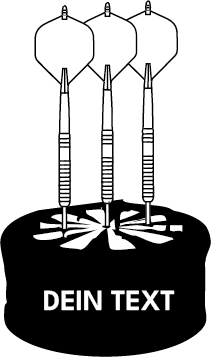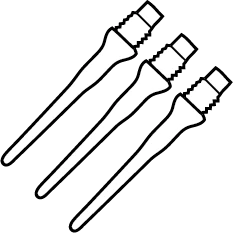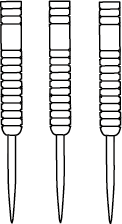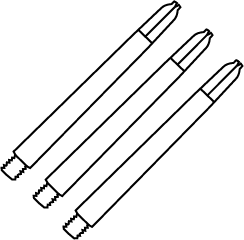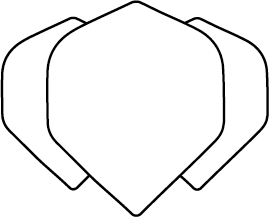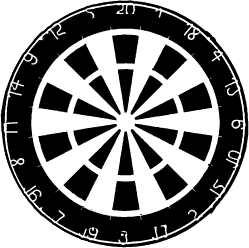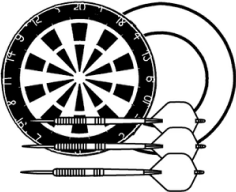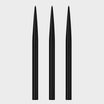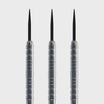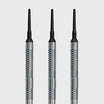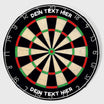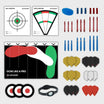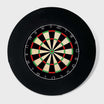Darts has been booming in Germany for several years now. Recent developments are causing ratings to skyrocket and many beginners to pick up darts .
But how exactly did darts come to Germany, and how long has the sport existed as we know it today? We'll give you an overview of darts' history !
The roots of darts history lie in England
It's still unclear exactly when darts first began being thrown at targets. The origins of darts can be traced back to the late 19th century . Back then, however, players didn't yet use high-quality dartboards made of sisal fibers.
Instead, they used simple wooden barrel ends , which were converted into a disc hanging on the wall. The current division of the fields on the disc is therefore reminiscent of the structure of a wooden disc .
Structure of a dartboard comes from a tree disc
There are also some clues regarding the division of the dartboard segments. If you look at the structure of a typical tree slice, you'll see that the cracks in a dried-out tree slice often resemble the thin steel wires of a dartboard . This explains how the double and triple fields on the board came to be divided.

Determination of the fields in 1896
The English carpenter Brian Gamlin established the division of the value segments (also called fields) that are still in use today in 1896 and laid the foundations for darts history.
Back then, the Brit wanted to invent a game that was as varied and exciting as possible. To achieve this, he usually arranged two low segments next to the high areas. This arrangement has proven particularly useful today, as it is precisely this arrangement that decides major matches, especially in professional darts.

When did the first evidence of the origin of darts emerge?
Of course, there is still heated debate today about exactly when darts first began and where darts' history begins. There is hardly any evidence left.
It's only partly possible to surmise exactly how it originated and what developments followed. However, a newspaper from 1901 shows that an advertisement for dartboards suggests that darts already existed at the beginning of the 20th century .
The 1930s – a time when long wooden arrows were still used
The perfected, lightweight darts made of brass or tungsten that we know today were unheard of in darts in the past. Back in the early days of darts, players still used wooden darts with a metal tip and a feather at the end .
It wasn't until around the time of World War II that the first brass darts appeared on the market. Suddenly, darts became a mass phenomenon. In 1937, around 300,000 participants registered for the largest tournament of all time.
We're talking about the city championship in London at the time. Even the royals didn't miss this event, as the Queen Mother opened the matches with a throw of her own. A milestone in darts history.
Court case becomes a breakthrough for darts
Despite the sometimes enthusiastic response, darts continued to be considered gambling in England. Because gambling was prohibited in pubs, a pub owner in Leeds was prosecuted.
The defendant brought his darts and a dartboard to the court hearing and demonstrated to the judge on site that darts is not a game of chance.
After several games, the judge agreed and was impressed to see that the darts landed on the board not randomly, but intentionally . As a result, the ban on darts in pubs was overturned, and soon afterward, a dartboard could be found in almost every British pub .
The way for the further success of darts history was thus paved.
The dart will also be perfected in the coming decades
Players repeatedly noticed that darts of that era were quite unwieldy . They also wore out quickly, requiring constant replacements .
To increase durability and comfort for players, the dart continued to evolve. In the 1960s, a breakthrough in darts history occurred that continues to this day .
Tungsten was first discovered as a material for darts . Its high density made it possible to produce relatively narrow darts that were nevertheless heavy .
Even today, this revolution in dart manufacturing is indispensable.

The level is getting higher – darts is expanding
Not only did the better darts significantly raise the level of the players , but darts in general took its first major steps into the wider world in the 1980s.
Great Britain was already in the grip of darts fever, and now it was time to make the British sport known throughout the world. Especially in the early 1980s, the sport boomed in England like never before. Even TV broadcasts drew millions of viewers .
Darts is also attracting attention in Germany for the first time
At that time, darts had long since reached its peak in England, but there was hardly any sign of it in Germany. In some pubs, only the familiar dart machines were available.
Steel tip darts were still virtually unknown. However, this changed at the beginning of the 21st century, and darts history entered Germany. In 2004, the sports broadcaster "DSF" secured the rights to the PDC Darts World Championship.
Two days before Christmas Eve, the first match between Mark Holden and James Wade was broadcast live. Even cult commentator Elmar Paulke still raves about the first match on German television. In the years that followed, darts slowly but steadily emerged as a popular sport.
Viewer ratings in the millions
In recent years, a real hype has developed around darts and the history of darts. Steel tip darts, in particular, have become increasingly popular . More and more pubs are installing steel tip dartboards next to their standard dart machines.
In addition , the first organized leagues and teams were founded in German-speaking countries. Especially since 2010, darts has also seen increasing ratings on television.
The rights to the World Championship still belong to Sport1 (formerly DSF). The World Championship final between Phil Taylor and Rob Cross on New Year's Day this year was watched by an average of more than 2 million viewers. A rating that would have been completely absurd in darts a few years ago.

No end in sight – the market continues to grow
There's still no end in sight to this positive development in darts history. The market for darts and boards continues to grow.
New leagues , new teams , and new entrants are putting the sport in the spotlight. Many veteran players often complain that the sport is being flooded with unsuspecting newcomers.
Nevertheless, darts has the potential to become a popular sport in Germany as well – as long as commercialization remains within limits.
Ready to immerse yourself in the fascinating world of darts? Discover the secrets, tactics, and captivating stories behind this exciting sport. Click in now and become a darts enthusiast!
- Darts on TV : Pure thrills. Experience exciting tournaments and legends live. Find out more and see the pros in action! Click here! ✓
- The most impressive Darts records at a glance. Get informed and be amazed now. Immerse yourself in the incredible world of elite darts.
- Darts Walk-On Music – The musical prelude to your darts adventure & the key to the perfect atmosphere. Click here to experience the sound of the pros!
Das im Beitrag gezeigte Bildmaterial mit Bezug zu Dartspielern und verwandten Themen unterliegt – sofern nicht anders angegeben – dem Copyright der Professional Darts Corporation (©pdc)




